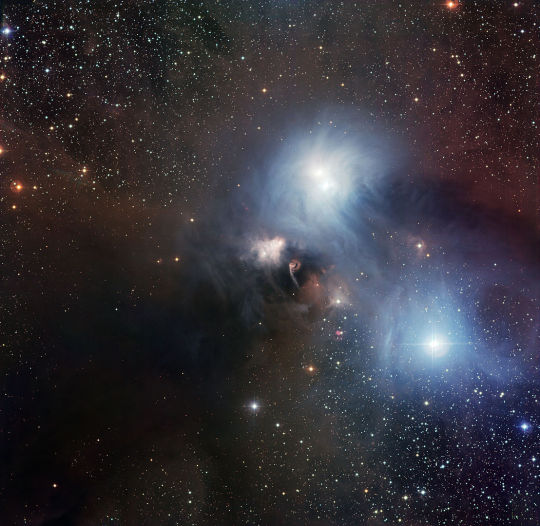#NGC 6729
Text

The Corona Australis Molecular Cloud // Ogetay Kayali
Note the globular cluster NGC 6723 projected near the cloud!
#astronomy#astrophotography#nebula#dark nebula#reflection nebula#dust#interstellar dust#molecular cloud#corona australis molecular cloud#NGC 6729#NGC 6727#NGC 6726#stars#star cluster#globular cluster#NGC 6723#corona australis
118 notes
·
View notes
Text


15 notes
·
View notes
Text
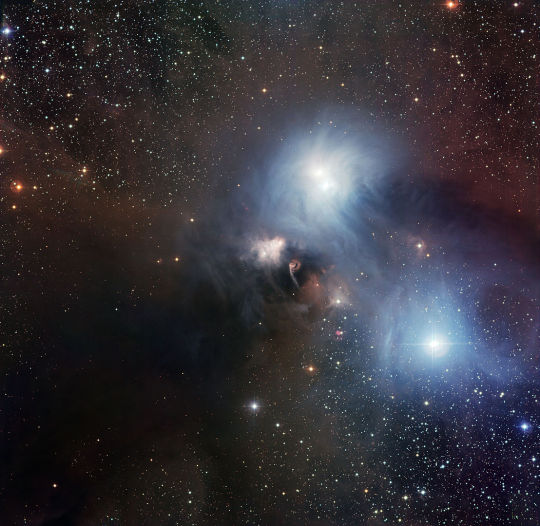
NGC 6729 (also known as Caldwell 68).
Distance: ~424 light-years.
#space#follow#followback#science#nature#astronomy#Universe#Cosmos#Astrophotography#NASA#night sky#stars#astro community#outer space#astrophysics#nebula#cosmology
260 notes
·
View notes
Photo

2023 June 22
Stars and Dust across Corona Australis
Image Credit & Copyright: Alessandro Cipolat Bares
Explanation: Cosmic dust clouds cross a rich field of stars in this telescopic vista near the northern boundary of Corona Australis, the Southern Crown. Part of a sprawling molecular cloud complex this star forming region is a mere 500 light-years away. That's about one third the distance of the more famous stellar nursery known as the Orion Nebula. The 2 degree wide frame would span 15 light-years at the clouds' estimated distance. Mixed with bright nebulosities the dust clouds effectively block light from more distant background stars in the Milky Way and obscure from view embedded stars still in the process of formation. Large dark nebula Bernes 157 is on the left. To its right are a group of pretty reflection nebulae cataloged as NGC 6726, 6727, 6729, and IC 4812. Their characteristic blue color is produced as light from hot stars is reflected by the cosmic dust. The more compact NGC 6729 surrounds young variable star R Coronae Australis. Just below it, filamentary arcs and loops are identified as Herbig Haro objects associated with energetic newborn stars. In fact, at the heart of this area lies the Coronet Cluster, one of the nearest and most active star forming regions.
∞ Source: apod.nasa.gov/apod/ap230622.html
73 notes
·
View notes
Photo
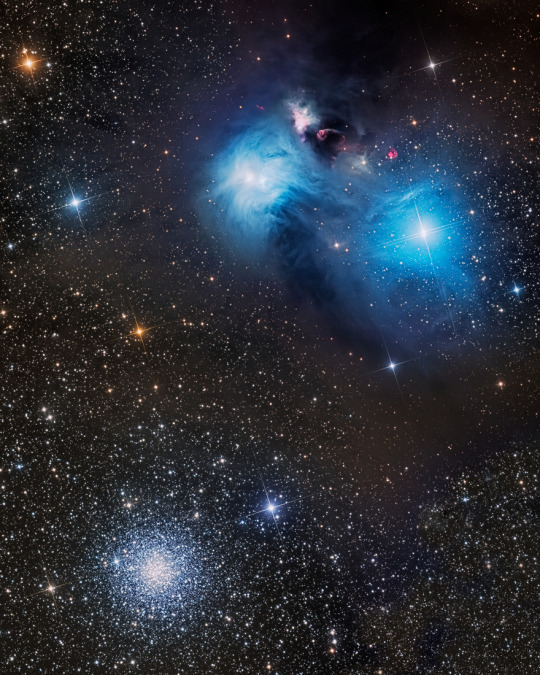
Stars and Dust Across Corona Australis : Cosmic dust clouds cross a rich field of stars in this telescopic vista near the northern boundary of Corona Australis, the Southern Crown. Less than 500 light-years away the dust clouds effectively block light from more distant background stars in the Milky Way. Top to bottom the frame spans about 2 degrees or over 15 light-years at the clouds' estimated distance. At top right is a group of lovely reflection nebulae cataloged as NGC 6726, 6727, 6729, and IC 4812. A characteristic blue color is produced as light from hot stars is reflected by the cosmic dust. The dust also obscures from view stars in the region still in the process of formation. Just above the bluish reflection nebulae a smaller NGC 6729 surrounds young variable star R Coronae Australis. To its right are telltale reddish arcs and loops identified as Herbig Haro objects associated with energetic newborn stars. Magnificent globular star cluster NGC 6723 is at bottom left in the frame. Though NGC 6723 appears to be part of the group, its ancient stars actually lie nearly 30,000 light-years away, far beyond the young stars of the Corona Australis dust clouds. via NASA
954 notes
·
View notes
Text

In the distance is a small nebula called R CrA (NGC 6729)... and that’s where we’re going!
3 notes
·
View notes
Text
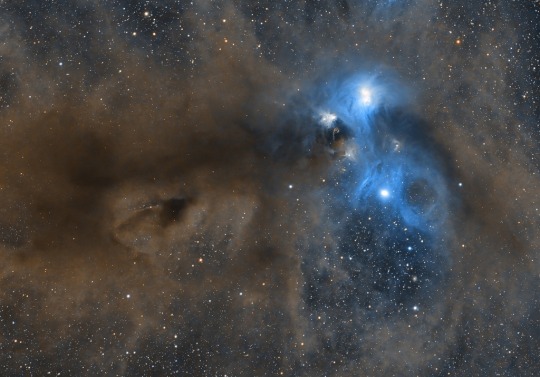
APOD: Stars and Dust across Corona Australis (6/22/23)
Cosmic dust clouds cross a rich field of stars in this telescopic vista near the northern boundary of Corona Australis, the Southern Crown. Part of a sprawling molecular cloud complex this star forming region is a mere 500 light-years away. That's about one third the distance of the more famous stellar nursery known as the Orion Nebula. The 2 degree wide frame would span 15 light-years at the clouds' estimated distance. Mixed with bright nebulosities the dust clouds effectively block light from more distant background stars in the Milky Way and obscure from view embedded stars still in the process of formation. Large dark nebula Bernes 157 is on the left. To its right are a group of pretty reflection nebulae cataloged as NGC 6726, 6727, 6729, and IC 4812. Their characteristic blue color is produced as light from hot stars is reflected by the cosmic dust. The more compact NGC 6729 surrounds young variable star R Coronae Australis. Just below it, filamentary arcs and loops are identified as Herbig Haro objects associated with energetic newborn stars. In fact, at the heart of this area lies the Coronet Cluster, one of the nearest and most active star forming regions.
© Alessandro Cipolat Bares
0 notes
Photo

Stars and Dust across Corona Australis via NASA https://ift.tt/ORNFxra Cosmic dust clouds cross a rich field of stars in this telescopic vista near the northern boundary of Corona Australis, the Southern Crown. Part of a sprawling molecular cloud complex this star forming region is a mere 500 light-years away. That's about one third the distance of the more famous stellar nursery known as the Orion Nebula. The 2 degree wide frame would span 15 light-years at the clouds' estimated distance. Mixed with bright nebulosities the dust clouds effectively block light from more distant background stars in the Milky Way and obscure from view embedded stars still in the process of formation. Large dark nebula Bernes 157 is on the left. To its right are a group of pretty reflection nebulae cataloged as NGC 6726, 6727, 6729, and IC 4812. Their characteristic blue color is produced as light from hot stars is reflected by the cosmic dust. The more compact NGC 6729 surrounds young variable star R Coronae Australis. Just below it, filamentary arcs and loops are identified as Herbig Haro objects associated with energetic newborn stars. In fact, at the heart of this area lies the Coronet Cluster, one of the nearest and most active star forming regions.
0 notes
Photo

NGC 6729 [Star Forming Region]
#NGC 6729#Star Forming Region#nasa#stargazing#astrophoto#astrophotography#galaxy#astronomy#universe#space#nebula#spinningblueball#milky way#milky way galaxy#star
153 notes
·
View notes
Text
Телескоп «Хаббл» зробив світлину галактичної туманності в сузір'ї Південна Корона
Теле��коп «Хаббл» зробив світлину галактичної туманності в сузір’ї Південна Корона
Телескоп Hubble, який є спільним проектом Національного управління з аеронавтики й дослідження космічного простору США (National Aeronautics and Space Administration, NASA) та Європейського космічного агентства (European Space Agency, ESA), зробив знімок галактичної туманності Caldwell 68 (також відома як NGC 6729), що розташована в сузір’ї Південна Корона на відстані в 400 світлових років від…
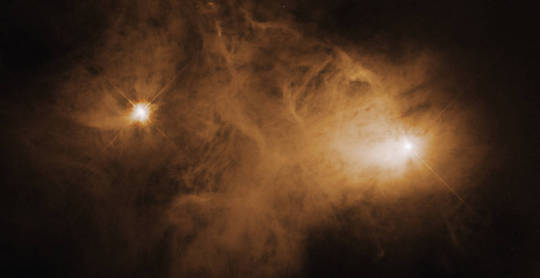
View On WordPress
#Caldwell 68#Галактична туманність#Південна Корона#США#Сузір’я#Телескоп#Хаббл#ESA#European Space Agency#HST#Hubble#Hubble Space Telescope#NASA#NGC 6729#USA
0 notes
Text

NGC 6729 // Interestar
#astronomy#astrophotography#nebula#reflection nebula#star-forming region#dust#interstellar dust#molecular cloud#NGC 6729#corona australis
39 notes
·
View notes
Text
Round 1 is here!

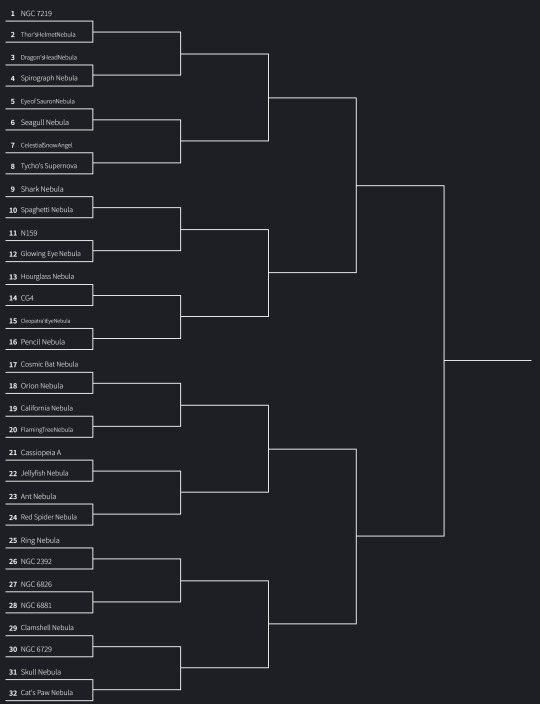
sorry for the two brackets, Bracket HQ wouldn't let me do 64. I'll be treating them like they're all one bracket though.
Links to polls:
NGC 2440 vs Hen 2-47
NGC 6572 vs Fetus Nebula
Eagle Nebula vs Cone Nebula
Butterfly Nebula vs Fine Ring Nebula
Heart Nebula vs Ghost Nebula
Baby Eagle Nebula vs Veil Nebula
Cat's Eye Nebula vs Crab Nebula
NGC 3576 vs Horsehead Nebula
LDN 1165 vs Tarantula Nebula
Tulip Nebula vs Robin's Egg Nebula
Rosette Nebula vs Helix Nebula
Lemon Slice Nebula vs Ghostly Hand Nebula
Carina Nebula vs Ghost of Jupiter Nebula
Bubble Nebula vs Jewel Bug Nebula
Red Rectangle Nebula vs NGC 1514
Crescent Nebula vs Witch Head Nebula
NGC 7219 vs Thor's Helmet Nebula
Dragon's Head Nebula vs Spirograph Nebula
Eye of Sauron Nebula vs Seagull Nebula
Celestial Snow Angel vs Tycho's Supernova
Shark Nebula vs Spaghetti Nebula
N159 vs Glowing Eye Nebula
Hourglass Nebula vs CG4
Cleopatra's Eye Nebula vs Pencil Nebula
Cosmic Bat Nebula vs Orion Nebula
California Nebula vs Flaming Tree Nebula
Cassiopeia A vs Jellyfish Nebula
Ant Nebula vs Red Spider Nebula
Ring Nebula vs NGC 2392
NGC 6826 vs NGC 6881
Clamshell Nebula vs NGC 6729
Skull Nebula vs Cat's Paw Nebula
12 notes
·
View notes
Photo

(NASA) Stars and Dust in Corona Australis
Image Credit & Copyright: Eric Coles & Martin Pugh
Blue dust clouds and young, energetic stars inhabit this telescopic vista, less than 500 light-years away toward the northern boundary of Corona Australis, the Southern Crown. The dust clouds effectively block light from more distant background stars in the Milky Way. But the striking complex of reflection nebulas cataloged as NGC 6726, 6727, and IC 4812 produce a characteristic blue color as light from the region's bright blue stars is reflected by the cosmic dust. The dust also obscures from view stars still in the process of formation. At the left, smaller yellowish nebula NGC 6729 bends around young variable star R Coronae Australis. Just below it, glowing arcs and loops shocked by outflows from embedded newborn stars are identified as Herbig-Haro objects. On the sky this field of view spans about one degree, corresponding to almost nine light-years at the estimated distance of the nearby star forming region.
Source
#astronomy#reflexion nebulas#NGC 6726#NGC 6727#IC 4812#nebula NGC 6729#Corona Australis/Southern Crown
2 notes
·
View notes
Photo
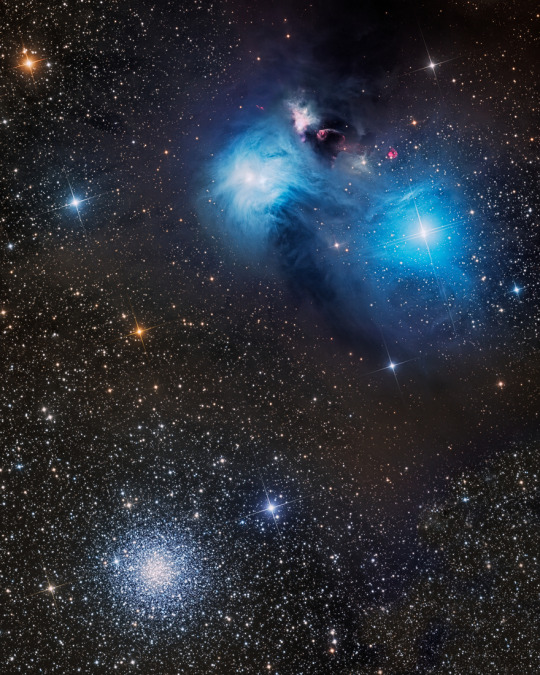
2021 August 6
Stars and Dust Across Corona Australis
Image Credit & Copyright: Vikas Chander
Explanation: Cosmic dust clouds cross a rich field of stars in this telescopic vista near the northern boundary of Corona Australis, the Southern Crown. Less than 500 light-years away the dust clouds effectively block light from more distant background stars in the Milky Way. Top to bottom the frame spans about 2 degrees or over 15 light-years at the clouds' estimated distance. At top right is a group of lovely reflection nebulae cataloged as NGC 6726, 6727, 6729, and IC 4812. A characteristic blue color is produced as light from hot stars is reflected by the cosmic dust. The dust also obscures from view stars in the region still in the process of formation. Just above the bluish reflection nebulae a smaller NGC 6729 surrounds young variable star R Coronae Australis. To its right are telltale reddish arcs and loops identified as Herbig Haro objects associated with energetic newborn stars. Magnificent globular star cluster NGC 6723 is at bottom left in the frame. Though NGC 6723 appears to be part of the group, its ancient stars actually lie nearly 30,000 light-years away, far beyond the young stars of the Corona Australis dust clouds.
∞ Source: apod.nasa.gov/apod/ap210806.html
180 notes
·
View notes
Photo
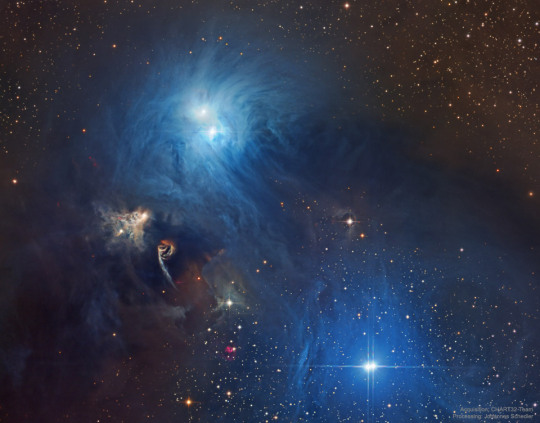
Stars and Dust in Corona Australis : Cosmic dust clouds and young, energetic stars inhabit this telescopic vista, less than 500 light-years away toward the northern boundary of Corona Australis, the Southern Crown. The dust clouds effectively block light from more distant background stars in the Milky Way. But the striking complex of reflection nebulae cataloged as NGC 6726, 6727, and IC 4812 produce a characteristic blue color as light from the region's young hot stars is reflected by the cosmic dust. The dust also obscures from view stars still in the process of formation. At the left, smaller yellowish nebula NGC 6729 bends around young variable star R Coronae Australis. Just below it, glowing arcs and loops shocked by outflows from embedded newborn stars are identified as Herbig-Haro objects. On the sky this field of view spans about 1 degree. That corresponds to almost 9 light-years at the estimated distance of the nearby star forming region. via NASA
680 notes
·
View notes
